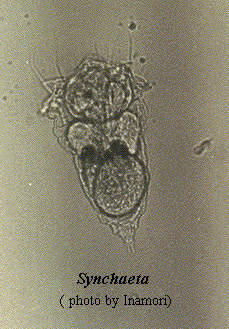
Rotifers are among the more bizarre animals found on this planet. They are small, being only slightly larger than a protozoan, and are typically too small to be seen without a microscope. They range from 0.1 to 1 mm in length. In most animals, growth is obtained by an increasing number of cells. This is not the case in rotifers; their cells just get bigger, so that the number of cells in their body remains constant. Despite their size, rotifers have a complex anatomy. The body can be divided into three main sections: a head, a trunk, and a foot. The head contains the corona, which in turn contains cilia. The cilia are arranged in a circle and beat one after the other, giving the appearance of a rotating wheel, and is where the term "rotifer" originated. The trunk is the main part of the body, and is protected by a stiffened armour known as the lorica. The lorica can be divided into plates or rings, with each plate or ring containing spines, ridges, etc. The last section, the foot, ends in contractile toes, which allow the rotifer to attach itself to objects such as plants. Some species secrete an adhesive to keep them anchored in place.
Rotifers are typically transparent, but can appear to be green, brown, red, or orange, depending on the colouration of the digestive tract. Even though they are small, they do have organs, including a mastax, which grinds the food, a pharynx and esophagus, a stomach, reproductive organs, the intestine, an anus, a bladder, etc. They also have a nervous system consisting of nerves that extend to the sensory organs and other areas of the body. The nerves send messages to and from the "brain", a mass of cells known as a ganglia. The sensory organs consist of bristles on the corona, antennae, and one or two eyes that contain a few photo receptors.
Rotifers are typically found in freshwater. However, some species are marine, terrestrial, or even parasitic. Most spend solitary lives, but some live in colonies. They move by crawling or swimming, but may do neither, living sessile lives anchored to one spot.
Reproduction is varied. For most species, the males have never been discovered, and may not even exist. This is because many species reproduce asexually in a fascinating process known as parthogenesis. Parthogenesis is a term used to describe unfertilized eggs becoming mature organisms. In this case, the female produces one or two diploid eggs (eggs with the full number of chromosomes) via mitosis (a type of cell division in wich two daughter cells are created that are identical to the parent cell). These eggs then develop into females, without ever being fertilized by a male.
In other species, in which both sexes are present, sexual reproduction may occur. In these cases, the female produces haploid eggs (eggs with half the number of chromosomes — at fertilization, the haploid sperm of the male would combine with the egg to produce a diploid zygote) via meiosis (a form of cell division more complicated than mitosis that has two stages. Ends up with four daughter cells that have half the number of chromosomes as the original parent cell). These haploid eggs that are produced by the female have two options. They can either remain unfertilized and undergo parthogenesis to develop into haploid males, or they can be fertilized by the male and develop into diploid females.
There are roughly 2000 species of rotifers described today. They are placed in three classes:
 Bdelloidea (bdelloid rotifers)) 360 spp
Bdelloidea (bdelloid rotifers)) 360 spp
 Monogononta (monogonontid rotifers)1600 spp
Monogononta (monogonontid rotifers)1600 spp
 Seisonidea (parasitic rotifers) 2 spp
Seisonidea (parasitic rotifers) 2 spp